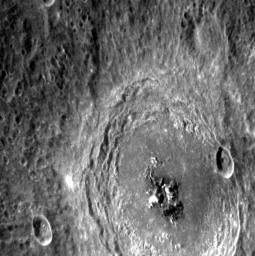This NAC image gives us an excellent view of the complex crater Bartok. Some of its most prominent features are the areas of bright material, as well as the central peaks and terraced walls. These features, combined with the fact that Bartok's eject blanket appears to cover much of the surrounding area, indicate that Bartok is younger than most of the neighboring terrain (but older than the two small craters to its left and right, as they fall on top of the crater's ejecta blanket and rim, respectively).
This image was acquired as a high-resolution targeted observation. Targeted observations are images of a small area on Mercury's surface at resolutions much higher than the 200-meter/pixel morphology base map. It is not possible to cover all of Mercury's surface at this high resolution, but typically several areas of high scientific interest are imaged in this mode each week.
Date acquired: May 03, 2012
Image Mission Elapsed Time (MET): 244519749
Image ID: 1754753
Instrument: Narrow Angle Camera (NAC) of the Mercury Dual Imaging System (MDIS)
Center Latitude: -28.34°
Center Longitude: 225.3° E
Resolution: 122 meters/pixel
Scale: Bartok crater is about 90 km (46 miles) in diameter.
Incidence Angle: 30.9°
Emission Angle: 49.7°
Phase Angle: 78.1°
The MESSENGER spacecraft is the first ever to orbit the planet Mercury, and the spacecraft's seven scientific instruments and radio science investigation are unraveling the history and evolution of the Solar System's innermost planet. Visit the Why Mercury? section of this website to learn more about the key science questions that the MESSENGER mission is addressing. During the one-year primary mission, MDIS acquired 88,746 images and extensive other data sets. MESSENGER is now in a year-long extended mission, during which plans call for the acquisition of more than 80,000 additional images to support MESSENGER's science goals.
These images are from MESSENGER, a NASA Discovery mission to conduct the first orbital study of the innermost planet, Mercury. For information regarding the use of images, see the MESSENGER image use policy.

 Planetary Data System
Planetary Data System












